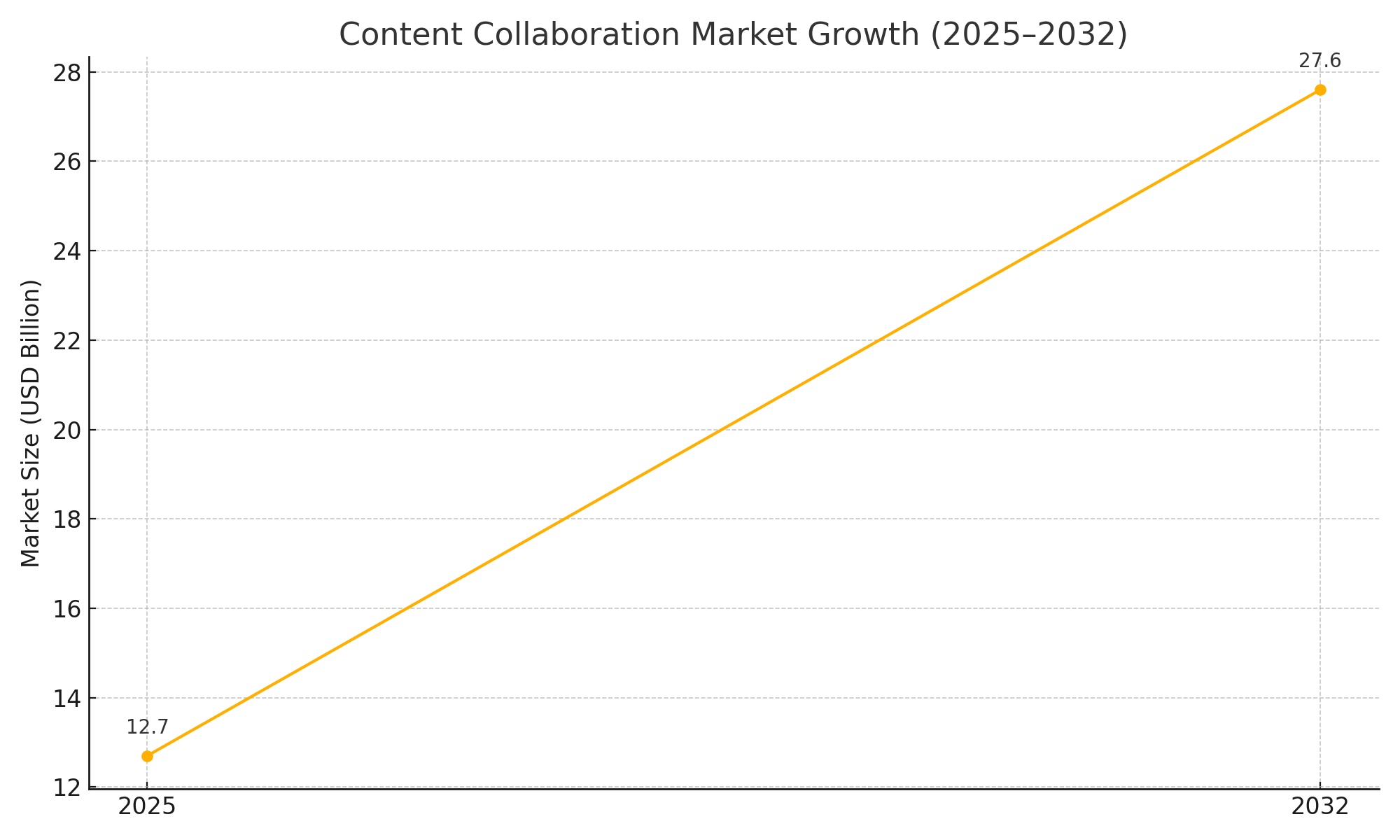Content Collaboration: Market Size, Forecast, Trends, and the Rise of Co-Creation
A data-driven look at the content collaboration market, emerging trends, regional growth, and why co-creation is now essential for creators and digital brands worldwide.

Content collaboration has become one of the most effective growth strategies for today’s creators and digital brands. As online competition intensifies and audiences demand authenticity, co-creating content offers a powerful way to expand reach, strengthen credibility, and accelerate personal or business branding. Whether you are a creator, entrepreneur, or independent professional, collaboration now plays a central role in audience growth and digital influence.
With the global content collaboration market projected to reach US$27.6 billion by 2032, opportunities are expanding across regions - led by North America, rapidly rising in Asia Pacific, and steadily growing in Europe. This article examines the future of content collaboration from 2026 to 2032, highlighting key Collaboration trends, category insights, regional dynamics, and the growing impact of co-creation across mainstream and niche digital industries.
Market Size & Forecast (2025–2032)
Content collaboration is experiencing sustained global momentum. Based on forecasts, the market is expected to nearly double from US$12.7 billion in 2025 to US$27.6 billion by 2032, reflecting strong adoption across creator communities, enterprises, media sectors, and emerging digital ecosystems.

From 2026 to 2032, content collaboration is poised to grow due to:
- Rising demand for authentic, multi-voice storytelling
- Expansion of creator partnerships across platforms
- Increased investment from brands in community-centric content
- Growth of new content formats and multi-creator media
- Adoption of AI-enhanced creation techniques
Collaboration is shifting from a marketing add-on to a foundational digital strategy for visibility, trust, and long-term reach.
Key Industry Highlights
Leading Region (2025): North America - 40% Market Share
North America dominates the global market due to its mature digital infrastructure, strong creator economy, and high investment in branded content. The U.S. and Canada also lead in early adoption of advanced content techniques, strategic collaborations, and performance-driven storytelling.
Fastest-Growing Region: Asia Pacific
Asia Pacific’s explosive growth is driven by rapidly expanding social media usage, booming e-commerce markets, and a rising creator community across India, China, Southeast Asia, and South Korea. Mobile-first audiences and localized content formats amplify collaboration demand.
Dominant Industry Type: Technology – 35% Market Share
The technology sector leads in content collaborations due to digital-native audiences, faster adoption of new content formats, and consistently high marketing spend.

Market Factors – Growth, Barriers & Opportunities
Growth Driver: Digital Marketing & Authentic Storytelling
As brands and creators compete for attention in crowded digital spaces, authenticity has become the differentiator. Audiences, especially Millennials and Gen Z prefer relatable, personality-driven content over traditional advertising.
Collaboration fuels authenticity by:
- Bringing diverse voices and perspectives into a single narrative
- Combining audiences for stronger organic reach
- Allowing creators to tap into communities built by peers
- Enabling immersive storytelling through shared content formats
User-generated content, live collaborations, interviews, co-hosted content, and joint campaigns continue to gain engagement. AI-driven insights allow creators and brands to personalize stories with greater accuracy, making collaborations even more effective.
Market Barrier: High Coordination & Intellectual Property Costs
Despite strong growth, several challenges continue to limit the scalability of content collaboration:
- Coordinating multiple creators, brands, or cross-border teams
- Managing contracts, usage rights, licensing, and long-term IP ownership
- Legal complexity when content is co-created or co-distributed
- Ensuring fair and transparent revenue distribution
- Navigating differing copyright and data regulations across regions
- Emerging uncertainty around AI-generated and AI-assisted content ownership
These structural challenges increase operational complexity for both creators and organizations. As collaborations expand across industries and geographies, IP governance, rights verification, and multi-party coordination require more standardized frameworks.
New platforms such as Miss Bliss are emerging specifically to address these pain points—by simplifying collaboration workflows, improving transparency around rights, and supporting fair revenue-sharing structures for creators. While the industry still lacks universal standards, the rise of dedicated collaboration ecosystems signals a future where multi-creator projects can become easier, safer, and more scalable.
The next phase of growth will depend on the adoption of clearer IP policies, standardized agreements, and secure digital verification mechanisms that protect creators while enabling frictionless co-creation.
Growth Opportunity: AI-Assisted Content Creation & Virtual Collaboration
AI is unlocking a new era of collaborative creativity. It enables:
- Faster creation of scripts, outlines, captions, and visual concepts
- Audience-based content personalization
- Multi-format content generation
- Smart suggestions during co-creation sessions
- Improved accessibility for emerging creators
- Virtual co-creation spaces that connect collaborators globally
AI does not replace creators, it enhances creative speed, improves narrative quality, and reduces friction in collaborative content production.
Category-Wise Analysis
| Industry Category | Reason for Collaboration Growth (2026–2032) |
|---|---|
| Technology | High content output + product education needs |
| Entertainment & Comedy | Viral, crossover, personality-driven |
| Lifestyle & Fashion | Visual, influencer-led, seasonal collabs |
| Education & Knowledge | Trust, expertise sharing, high retention |
| Gaming | Co-streaming, interactive collabs |
| Fitness | Challenges, community-driven content |
| Adult Content | High engagement in niche creator economy |
| Healthcare | Telehealth, awareness, informational content |
Content Type Insights
Videos hold a 40% market share in 2025, making them the most consumed and most effective format globally. Video collaborations, interviews, co-hosts, reaction content, duets, cross-platform highlights dominate digital consumption.
Podcasts are the fastest-growing format. Their storytelling depth, convenience, and strong adoption in professional and B2B environments contribute to rising demand.
Target Audience Insights
Millennials (30% share) lead content engagement due to high digital participation and strong purchasing power. They resonate with value-driven collaborative content.
Gen Z is the fastest-growing segment, favoring short-form, dynamic, highly authentic content. Their collaborative nature and comfort with co-creation make them a core driver of market growth.
Key Highlights Recap
- Leading Content Type: Videos (40%)
- Leading Audience: Millennials (30%)
- Major Growth Driver: Cloud-enabled digital expansion + AI-driven personalization
- Top Opportunity: Digitalization, mobile-first audiences, and creator-powered authenticity
Regional Insights
North America: 40% Share in 2025
North America’s content collaboration leadership stems from:
- Strong enterprise and creator adoption
- High digital maturity
- Integration of branded storytelling
- Rapid adoption of AI-enhanced content approaches
- Hybrid content creation models
The region’s mature corporate ecosystem and demand for high-quality narratives support long-term growth.
Europe: 22% Share in 2025
Growth in Europe is fueled by:
- Digital transformation across key industries
- Multi-country, cross-language collaboration needs
- Emphasis on authenticity in brand communication
- High adoption of hybrid creative models
- Regulatory standards improving content quality and ownership clarity
Multilingual content collaboration is becoming essential in the region.
Asia Pacific: Fastest-Growing Region
Asia Pacific’s momentum is driven by:
- Massive social media and mobile usage
- Expanding digital creator communities
- Strong e-commerce adoption
- Localized, culturally specific content needs
- Government-backed digitalization programs
India, China, Japan, and Southeast Asia lead with fast-growing creator ecosystems that rely heavily on co-creation.
What Content Collaboration Means in 2026–2032
Between 2026 and 2032, content collaboration becomes a mainstream strategy for all creators. It is characterized by:
- Shared ideas, shared audiences, and shared visibility
- Co-creation of videos, podcasts, posts, educational content, and storytelling formats
- Strategic partnerships that blend personality, expertise, and community
- Enhanced reach through cross-promotion and multi-platform amplification
- Growing use of AI for creation support and content optimization
Collaboration is no longer just a tactic — it is an economic engine for growth.
Global Trends Shaping 2026–2032
Key trends shaping the future include:
- AI-Augmented Co-Creation: Multi-format content generated and refined through intelligent assistance.
- Immersive Collaborations: Virtual, AR, and mixed reality environments for co-creating rich media.
- Content Pipelines: Unified creation-to-distribution models across platforms.
- Cross-Industry Partnerships: Brands, creators, educators, and niche sector experts co-producing content.
- Authenticity-Driven Models: Emotional, value-led narratives outperform promotional communication.
- Revenue-Sharing Evolution: Multi-party monetization becomes easier and more widely adopted.
Niche Industry Insight: Adult Content Collaboration (Non-Explicit)
While there is no verified market size specifically for adult content collaborations, industry behavior indicates clear growth:
- The digital adult content market shows consistent expansion.
- Collaborative content—co-created scenes, joint livestreams, shared storylines—performs significantly better in engagement and visibility.
- According to insights referenced in niche industry reports, collaborations help build personal branding, credibility, and audience loyalty.
- Co-creation reduces content burnout, expands cross-audience exposure, and increases monetization potential.
Future Outlook (2030–2032 and Beyond)
By 2032, the content collaboration landscape will be defined by:
- AI-driven collaborative ecosystems where creators produce faster and smarter
- Decentralized content ownership and rights frameworks
- Hyper-personalized, multi-creator content tailored to audience clusters
- Cross-border collaborative storytelling becoming mainstream
- Immersive content experiences driven by AR/VR
- Creator communities becoming power centers, shaping brand strategies
- Multi-party monetization models supporting long-term content IP partnerships
The future belongs to creators and brands who embrace collaboration as a strategic advantage, not just a content trend.
Conclusion
Content collaboration has moved from a niche strategy to a global growth engine. With the market expected to reach US$27.6 billion by 2032, creators and brands that invest in co-creation will continue to outperform competitors in reach, visibility, and audience connection.
North America leads with mature ecosystems, Europe focuses on quality and compliance, and Asia Pacific accelerates with scale and cultural diversity. Videos dominate, Millennials lead engagement, and AI unlocks new creative possibilities. Niche industries, including the adult creator economy, further illustrate how collaboration deepens impact and accelerates growth.
From 2026 to 2032, content collaboration will become the defining approach for creators and businesses seeking visibility, trust, and long-term digital influence.




